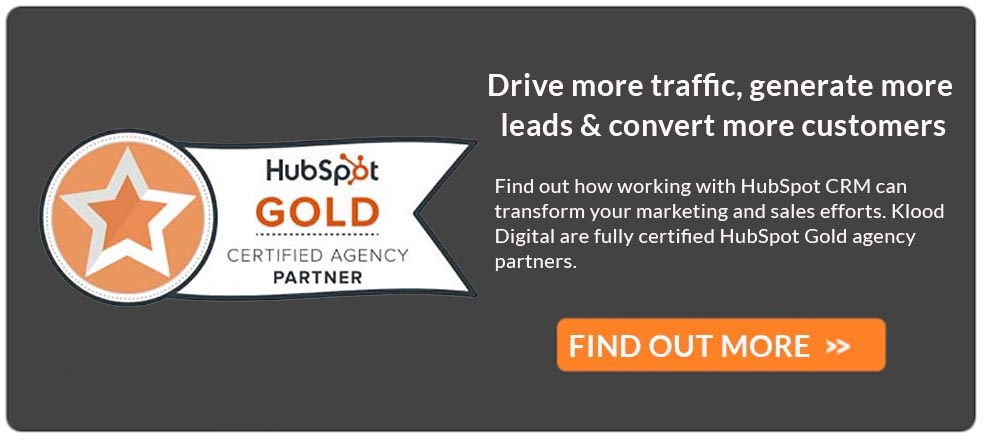How to Prioritise Your Marketing Budget
How to Prioritise Your Marketing Budget
Get weekly
HubSpot Updates
Unfortunately for most marketing managers, we are rarely given an infinite marketing budget to grow our businesses with and so deciding how to prioritise your marketing budget for the best return can be a daunting task.
Here are our top tips to help you start prioritising your marketing budget:
Define your business goals
Whether your business dedicates 5% or 15% of your revenue to marketing, it’s important to make sure you have a clear marketing strategy that is defined by the goals and objectives of the business if you hope to see a true return on your investment.
Although it can be difficult to get all key stakeholders in one room when you’re a growing business, it’s vital for all areas of the business to understand the business goals. More important still is to make sure the goals you set your business are SMART goals - Specific, Measurable, Attainable, Relevant and time-bound.
The data used to define your goals will be able to help you uncover how marketing can reach specific customers and allow you to gather an understanding of who your buyer personas are. Once you know who you want to be reaching with your marketing, you’ll be able to consider how these personas like to be communicated with, which social media channels they spend their time on and understand their challenges that will lead them to discovering your product or service.
Once the groundwork has been done on your goals, you will then be able to define the marketing strategy that you will use to achieve these goals. Your strategy will then be used to inform you on the best marketing mix to use and then what campaigns you will run.
Focus on what your business needs
If your business has decided to grow the company through digital marketing, make sure you have the marketing and sales procedures in place to effectively run your marketing plans.
For most businesses, your website will be your most hardworking marketing asset at your disposal, but does it communicate your brand message clearly, is it obvious what you do and who you sell to? Can visitors easily navigate around the website to find the information they are looking for? And most importantly, are they able to get in touch with you easily through your website?
If the answer to any of these questions are no, then you’ll of made your first priority - to improve your website. This may not mean a whole new website redesign, but it could be that you need to look into ways on continually improving your website through data-driven optimisation.
Find out more about how Growth-driven Design can drive more results from your website.
Does your current marketing and sales software have the right tools to allow you to do everything you need to hit your business goals? Once a website visitor becomes a lead, what happens to them? Do you have qualifying procedures in place to help the sales team know who they need to call, what do you do with the leads aren’t ready to buy yet? If you know your product or service tends to have a long sales process, your marketing budget would be well spent on a powerful email marketing automation tool to nurture your leads into customers.
Or maybe your current sales and marketing teams have no visibility of each others efforts? By investing some of your marketing budget into a strong marketing and sales CRM software you can start to really see the leads that marketing are generating and what happens when they are passed onto the sales team. By opening this communication you may shed light on marketing activities that are not yielding good results, see what channels are converting the most leads into customers and the sales team are able to feed back easily on the quality of leads so that the marketing team are able to learn more about the customers who are buying - and attract more of the same!
Develop Your Strategy
Once you understand your business needs and goals, you will then be able to develop your marketing strategy. A marketing strategy is not your budget, media plan or digital marketing tactics. Your marketing strategy should all be built around your well defined goals and be a clear path to help you achieve these for the business.
No matter the size of your budget, by figuring out how you aim to achieve your goals first through the strategy planning, you then be able to figure out the best investments for your marketing budget. Tactics such as pay-per-click, social media advertising or blogging are all great tools that might be part of your digital marketing strategy; but before you start carving out your budget to fit any of these into your marketing plan, be sure your marketing data backs up where you investing. Revert back to what you learnt about your buyer personas when you were defining your business goals and consider where you have the most potential to reach them and invest your limited time and budget here.

Create your targeted marketing campaigns
Now you know how you plan to market your business and you know who you’re planning on marketing to, you're now be able to make an informed decision on where your marketing budget can be spent for the biggest return on investment.
As you build out your campaigns and decide on the right marketing channels to focus your budget on, be sure to continually analyse the data of your existing campaigns to see how well you are performing at each step of your marketing plan. It is important to be flexible with your marketing campaigns to react to the information you are receiving through your website and lead data. Don’t be afraid to constantly tweak and optimise ads that you may have running, website pages and call-to-actions that your using to continually improve your conversion rates and overall results.
If you follow the above tips, you should be able to fully understand the impact of your marketing strategy when it come to analysing your results, seeing what marketing tactics have worked well for you (and what hasn't!), and then use this information to drive your next budgeting decisions in the future.
Our content includes affiliate links. This means that we may receive a commission if you make a purchase through one of the links on our website. This will be at no cost to you and helps to fund the content creation work on our website.
